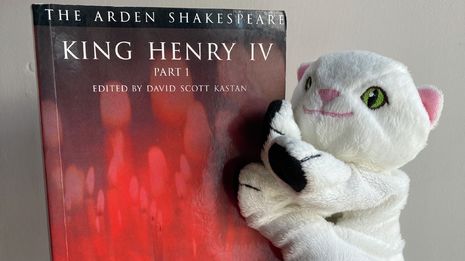‘Knick-knacks’: Cat puppet
In the latest instalment of her column, Eve Connor ponders cat puppets, Shakespeare and power in the wake of Charles III’s coronation

I found her in a bin bag. She is green-eyed and boulder-headed, her four legs impossible to operate together. Waving her paw with my finger, I started to wonder about the 18th-century German puppet show adapted from Hamlet, Der Bestrafte Brudermord, as well as Shakespeare more broadly – where puppetry intersects with pageantry, and what the English degree is doing to my brain.
Orson Welles’ Chimes at Midnight (1965) condenses five history plays into two hours, tracking the misadventures of Sir John Falstaff, a disgraced knight, and the delinquent Prince of Wales, Hal, who in Keith Baxter’s hands has the appearance of an ironic Robert De Niro. (Incidentally, the answer to whether young De Niro or Pacino was hotter is Marlon Brando.)
When Hal ascends to the throne and rejects Falstaff, he is leagues away from the bounding youth of the opening scenes, laughing almost to extravagance, constantly embracing, grasping and engaging with other bodies in the sweaty broil of the tavern. We are forced to view the coronation from a distance. “I know thee not, old man,” Hal says, a wall of black cloak, and for one devastating moment, it looks like he might not face Falstaff at all. The turn is worse. Hal condemns his former companions to banishment, and we discover a detached cruelty beneath his revels. Perhaps this is the true Hal, plotting as early as his first scene to betray Falstaff so that ‘he may be more wondered at / By breaking through the foul and ugly mists / Of vapours that did seem to strangle him.’ Then his chin trembles.
My litmus test for an adaptation of Henry IV Part 1 is the scene between Harry ‘Hotspur’ Percy and his wife, Kate. Played straight, Hotspur is a git. The last time he ever sees his wife, he tells her he doesn’t love her! Chimes at Midnight undercuts any solemnity by setting the action at bathtime. Attendants rush in to cover Norman Rodway’s Hotspur as he clambers out of the tub, barking aloud an offensive letter, while Kate, the amused Jeanne Moreau, attempts to rally his attention.
The innovation here is that Hotspur is energised by his anger. He rushes about in excitement, (all senses of the word) and calls for clothes, trumpets, a horse. He drops his towel during a broad theatrical gesture, baring his bum as fanfare fills the frame. Kate has witnessed this routine before. She laces up his jerkin as one might stay an impatient child. Hotspur wriggles away and she pursues him, detaining her husband by the pinkie and vowing, ‘in faith, I’ll break thy little finger, Harry, / An if thou wilt not tell me all things true.’ Their domesticity is important in the male-dominated world of the history plays, and it makes what follows hurt.
But what about puppets? I have been puzzling the Medieval distinction between the ‘body natural’ (the monarch’s physical body) and the ‘body politic’ (the institution, state, or nation), especially in the wake of Charles III’s big day. I caught a minute of the YouTube live stream and was struck by the powerlessness of the monarch. He is shuffled into the carriage, shuffled into Westminster Abbey, anointed, kissed and led in oath. The Archbishop of Canterbury twists the crown like my mother shimmying a blouse over my head in an H&M changing room. Up close, the crown is tall, bedazzled with a cake-frosting ermine band, the droopy gold baubles on either side of the cross trembling with anxiety. Throughout the adjustments, Charles blinks demurely at the carpet.
For Hal, or Hostspur, or the King, or me, our bodies are rarely entirely our own. Hal must put away childish things to become king (although the crown is surely the biggest toy of all, a dress-up game parodied by children for centuries). While his rejection of Falstaff seems like an abuse of power, it is also a submission to the institution Hal is entering. The crown is both an item of clothing and an institution, both puppet and puppeteer. As for Hotspur, his second body is the suit of armour next to him in the tub – appropriate for a soldier who talks about honour like it is solid. We might dare glance at Being John Malkovich (1999), in which a puppeteer locates a portal into the mind of, surprise, the actor John Malkovich – another second body – resulting in one of the weirdest films I have seen. When Kate holds Hotspur by the finger, the power slips: she can puppeteer him.
My camp cat needs a name. I am thinking Goneril. Gertrude? Possibly Mae West. And happy birthday to the First Folio, 400 this November! God save the puppets.
 News / Cambridge postgrad re-elected as City councillor4 May 2024
News / Cambridge postgrad re-elected as City councillor4 May 2024 News / Gender attainment gap to be excluded from Cambridge access report3 May 2024
News / Gender attainment gap to be excluded from Cambridge access report3 May 2024 Comment / Accepting black people into Cambridge is not an act of discrimination3 May 2024
Comment / Accepting black people into Cambridge is not an act of discrimination3 May 2024 News / Academics call for Cambridge to drop investigation into ‘race realist’ fellow2 May 2024
News / Academics call for Cambridge to drop investigation into ‘race realist’ fellow2 May 2024 News / Some supervisors’ effective pay rate £3 below living wage, new report finds5 May 2024
News / Some supervisors’ effective pay rate £3 below living wage, new report finds5 May 2024




